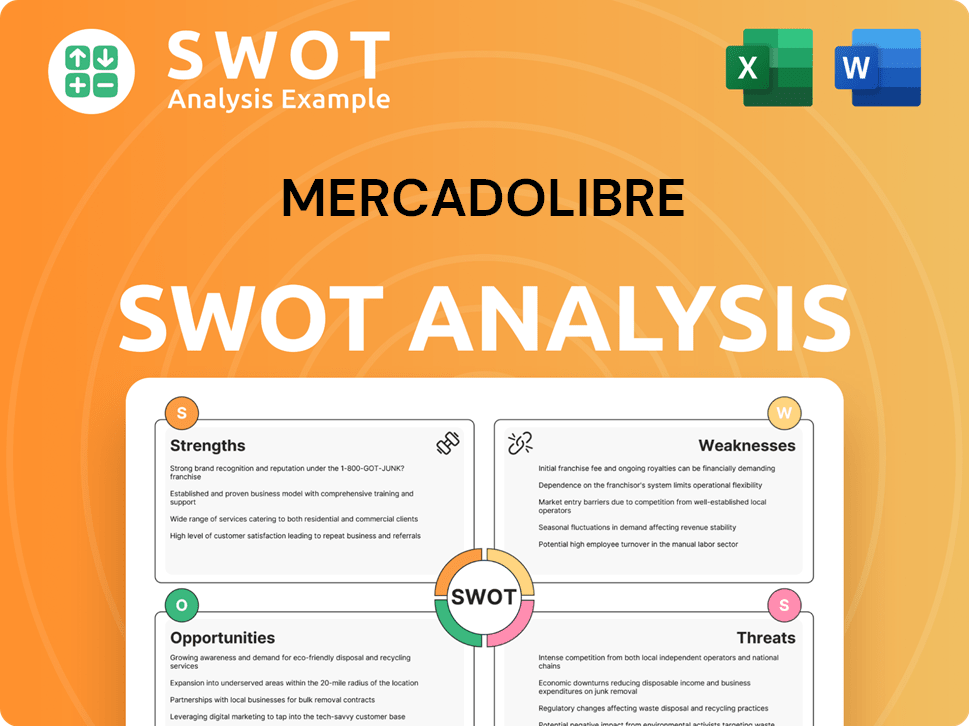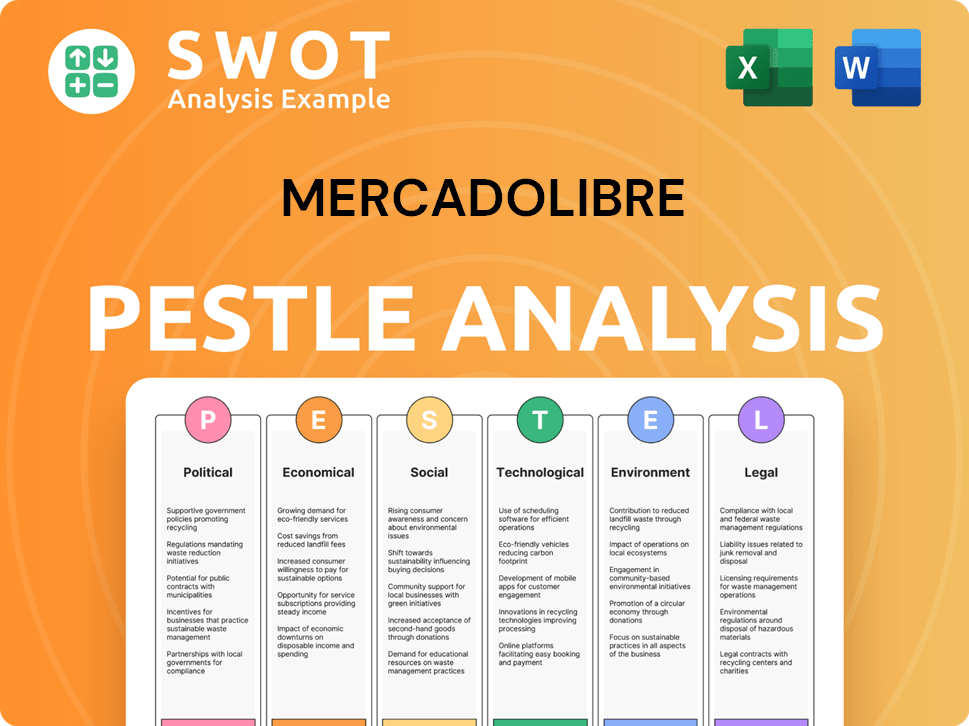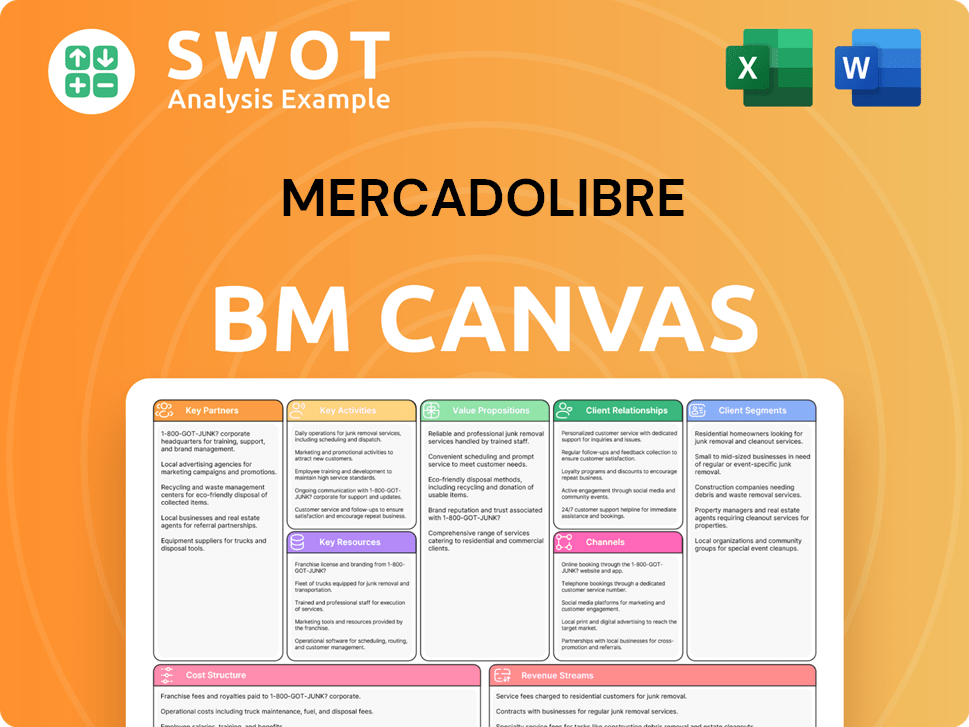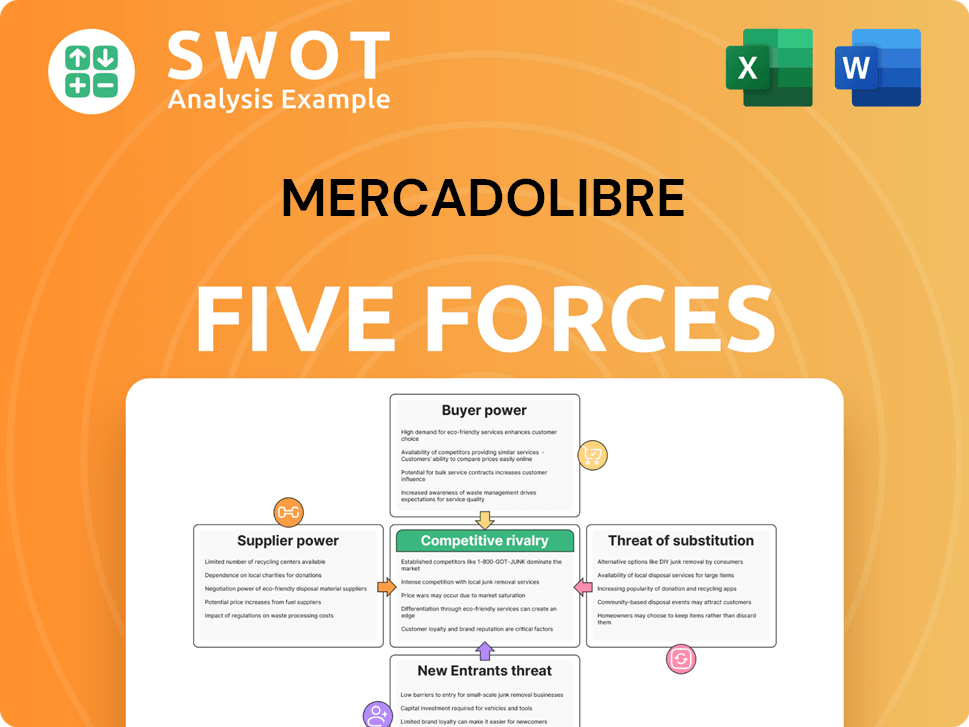MercadoLibre Bundle
Can MercadoLibre Maintain Its Dominance?
MercadoLibre, the Latin American e-commerce and fintech powerhouse, has captivated investors with its impressive growth trajectory. From its humble beginnings in Argentina to its current status as a $130 billion giant, the company's strategic evolution is a compelling case study. This article delves into the MercadoLibre SWOT Analysis, examining its growth strategy and future prospects.

Understanding MercadoLibre's MercadoLibre company analysis is crucial for anyone interested in the dynamic e-commerce landscape. We'll explore its innovative MercadoLibre business model, its expansion plans, and its competitive advantages in a region ripe with opportunity. This deep dive will also assess the MercadoLibre market share and its ambitious goals, offering insights into its potential for sustained growth and investment potential, especially considering the challenges and opportunities within e-commerce in Latin America.
How Is MercadoLibre Expanding Its Reach?
As part of its MercadoLibre growth strategy, the company is aggressively pursuing expansion initiatives, particularly in key markets such as Brazil and Mexico. These moves are designed to strengthen its position in the rapidly growing e-commerce sector in Latin America. The company's strategic investments are geared towards enhancing its logistics, technology, and marketing capabilities, as well as expanding its workforce.
These expansion plans are critical for MercadoLibre's future prospects, as they aim to capture new customers and diversify revenue streams. By focusing on both e-commerce and fintech, the company seeks to stay ahead of industry changes and maintain its competitive edge. The company's investments reflect a long-term commitment to growth and innovation in the region.
The company's approach to expansion involves significant financial commitments and strategic partnerships. This includes investments in infrastructure, technology, and human resources. These investments are designed to create a robust ecosystem that supports both buyers and sellers, driving sustainable growth and enhancing the overall user experience.
In April 2025, the company announced plans to increase its investment in Brazil by 48%. This increase, from 23 billion reais (about $3.7 billion) in 2024 to 34 billion reais (about $5.8 billion) in 2025, underscores the importance of the Brazilian market. This investment is primarily directed towards enhancing logistics, technology, marketing, and increasing its staff in the country.
The company plans to invest $3.4 billion in Mexico, its second-largest market. This significant investment is part of a broader strategy to expand its footprint and capture growth opportunities in the region. These investments are aimed at accessing new customers, diversifying revenue streams, and staying ahead of industry changes.
A crucial aspect of the company's expansion is its focus on fintech, particularly through Mercado Pago. The company aims to become Latin America's dominant digital banking force. The fintech platform reached 64 million monthly active users (MAUs) in Q1 2025, growing 31% year-over-year.
Mercado Pago's credit portfolio expanded by 75% to $7.8 billion. The company also issued 5.9 million new credit cards in 2024, doubling its credit book. These financial services are designed to drive user engagement and create new revenue streams.
The company's expansion initiatives are multi-faceted, focusing on both geographical and financial service growth. These strategies are designed to capitalize on the increasing demand for e-commerce and digital financial services in Latin America. For more insights into the company's ownership structure and financial performance, you can read more about the Owners & Shareholders of MercadoLibre.
- Increased investment in Brazil and Mexico to strengthen market presence.
- Aggressive growth of Mercado Pago to dominate the digital banking sector.
- Expansion of credit offerings and financial services to drive user engagement.
- Enhancement of logistics and technology infrastructure to support growth.
MercadoLibre SWOT Analysis
- Complete SWOT Breakdown
- Fully Customizable
- Editable in Excel & Word
- Professional Formatting
- Investor-Ready Format

How Does MercadoLibre Invest in Innovation?
The company's growth strategy heavily relies on technological innovation to meet evolving customer needs in the dynamic e-commerce landscape. This approach is crucial for maintaining its competitive edge and expanding its market share in Latin America. By focusing on cutting-edge technologies, the company aims to enhance user experiences, streamline operations, and offer innovative financial solutions.
Understanding customer preferences is key to the company's success. The company continuously analyzes user data, including browsing patterns and purchase history, to personalize shopping experiences. This data-driven approach helps the company anticipate demand, optimize inventory, and provide tailored recommendations, ultimately driving customer loyalty and boosting sales.
The company's commitment to innovation is evident in its significant investments in research and development (R&D). For the twelve months ending March 31, 2025, R&D expenses reached $2.027 billion, reflecting a 6.24% year-over-year increase. Furthermore, for the quarter ending March 31, 2025, R&D expenses were $551 million, marking a 20.31% increase year-over-year. These investments are essential for developing new products and services and improving existing ones.
The company's technology-driven logistics network is a critical component of its growth strategy. The network handles 95% of its packages, enabling 75% of orders to be delivered within 48 hours. This efficiency significantly enhances customer satisfaction and supports the company's e-commerce operations.
The company is increasingly integrating Artificial Intelligence (AI) and machine learning (ML) across its operations. AI powers personalized shopping experiences and optimizes logistics. This enhances productivity and improves service offerings, contributing to the company's overall efficiency.
The company continuously expands its fintech offerings to maintain its competitive edge. This includes Mercado Crédito, which provides credit lines, and the launch of 'Meli Dólar,' a stablecoin pegged to the US dollar. These services enhance its digital asset offerings and provide more financial options for users.
The relaunch of the Meli+ loyalty program in Brazil and Mexico in 2024 adds benefits such as cashback and extra installments. These enhancements aim to boost customer retention and increase the overall value proposition for users, contributing to the company's user growth statistics.
The company acknowledges the importance of data privacy and security in its operations. It is crucial to manage data responsibly and address potential biases in algorithms. This ensures that technological advancements are implemented ethically and effectively.
The company's commitment to continuous innovation is central to its future prospects. By consistently introducing new offerings and refining existing services, the company aims to maintain its market leadership and adapt to changing consumer demands. This approach supports its international expansion strategy.
The company's strategic initiatives are designed to drive long-term growth and enhance its competitive position. These initiatives include investments in technology, expansion of financial services, and improvements in logistics. These efforts are essential for the company's continued success in the e-commerce market. For more insights into the company's core values, consider reading about the Mission, Vision & Core Values of MercadoLibre.
- Investing in AI and ML to improve user experience and operational efficiency.
- Expanding Mercado Crédito to provide more financial solutions for buyers and sellers.
- Enhancing the logistics network to reduce shipping times and costs.
- Launching new digital asset offerings like 'Meli Dólar' to diversify services.
MercadoLibre PESTLE Analysis
- Covers All 6 PESTLE Categories
- No Research Needed – Save Hours of Work
- Built by Experts, Trusted by Consultants
- Instant Download, Ready to Use
- 100% Editable, Fully Customizable

What Is MercadoLibre’s Growth Forecast?
The financial outlook for MercadoLibre in early 2025 is notably positive, driven by substantial revenue and profit increases. This performance underscores the effectiveness of its MercadoLibre growth strategy in the dynamic Latin American market. The company's expansion and strategic initiatives are key factors in its continued success and MercadoLibre future prospects.
In the first quarter of 2025, the company demonstrated strong financial results, with significant growth in revenue, net income, and operational income. These figures highlight the company's robust financial health and its ability to capitalize on the burgeoning e-commerce market in Latin America. The sustained growth trajectory suggests that the company is well-positioned to maintain its leadership in the region.
In Q1 2025, net revenue surged to $5.9 billion, a 37% year-over-year increase. Net income also saw a significant rise, reaching $494 million, representing a 44% year-over-year increase. Income from operations reached $763 million, with an operating margin of 12.9%.
GMV in Q1 2025 increased by 17% year-over-year to $13.3 billion. The company also experienced a substantial increase in unique buyers, which grew by 25% year-over-year to nearly 67 million, demonstrating a strong user base.
Total Payment Volume (TPV) through Mercado Pago soared to $58.3 billion, marking a 43% year-over-year increase. Total payment transactions also rose by 38% year-over-year, exceeding 3.3 billion, showcasing the popularity of its payment solutions.
Mercado Pago's credit card portfolio experienced remarkable growth, with an impressive 111% year-over-year increase, reaching $3.2 billion. This highlights the successful expansion of its financial services.
Looking ahead, analysts anticipate continued strong performance. Projections indicate a revenue Compound Annual Growth Rate (CAGR) of 16% from 2024 to 2034. The EBIT margin is expected to remain at 13% in 2025, with operating leverage expected to improve to 20% in ten years. For further insights, a Brief History of MercadoLibre provides additional context on the company's evolution and strategic decisions.
Analysts forecast revenue growth of 23.4% and EPS growth of 23.7% per annum. This strong growth is expected to be driven by continued expansion in key markets and increased adoption of its services.
The EBIT margin is projected to remain at 13% in 2025, consistent with 2024 levels. Operating leverage is expected to improve over the next decade, reaching 20% in ten years, indicating improved efficiency.
Free cash flow reached a record $1 billion in 2024, demonstrating the company's strong cash generation capabilities. This robust cash flow supports future investments and strategic initiatives.
The company has actively managed its capital, including repurchasing debt securities in 2024. It has also suspended dividend payments since 2018 to prioritize reinvestment in growth opportunities, signaling a focus on long-term expansion.
A revenue CAGR of 16% is projected from 2024 to 2034. Growth is expected to moderate from 24% in 2025 to 10% by 2034 as the company matures, reflecting a shift towards sustainable, long-term expansion.
The company's strong financial performance and strategic initiatives position it favorably within the e-commerce in Latin America landscape. Its focus on innovation and user experience is key to maintaining its competitive advantage.
MercadoLibre Business Model Canvas
- Complete 9-Block Business Model Canvas
- Effortlessly Communicate Your Business Strategy
- Investor-Ready BMC Format
- 100% Editable and Customizable
- Clear and Structured Layout

What Risks Could Slow MercadoLibre’s Growth?
Despite its impressive growth, the future of MercadoLibre's growth strategy faces several significant risks and obstacles. These challenges span macroeconomic factors, intense competition, regulatory changes, and operational complexities. Understanding these potential pitfalls is crucial for assessing the company's long-term prospects and investment potential.
Macroeconomic instability in Latin America, particularly Argentina and Brazil, poses a considerable threat. High inflation and currency fluctuations in Argentina, combined with Brazil's economic struggles, can negatively impact consumer spending and profitability. The company must navigate these volatile conditions to maintain its growth trajectory.
Competition in the e-commerce market, especially from global giants and new entrants, presents a continuous challenge for MercadoLibre. The company's established ecosystem is a strong asset, but it's not impenetrable. Adapting to these pressures is critical for maintaining its market share and driving future growth.
Argentina's high inflation and currency fluctuations can dampen consumer spending. Brazil's economic slowdown has led to increased default risks. These factors directly affect MercadoLibre's financial performance and overall growth.
Intense competition from global e-commerce giants like Amazon and new Asian entrants poses a continuous challenge. Maintaining a competitive edge requires strategic investments and adaptability in the dynamic market environment.
Regulatory changes, especially in financial services, and operational challenges like supply chain issues can hinder operations. Navigating these complexities requires proactive risk management and strategic planning.
High non-performing loan ratios within Mercado Pago's credit portfolio signal potential risks. Currency fluctuations in emerging market currencies also exert short-term pressure on profitability. These financial aspects need careful monitoring.
Dependence on third-party logistics providers can lead to delivery delays. Operating in regions with organized crime poses risks to the reliability of the logistics network. These operational challenges can impact customer satisfaction.
Rapidly evolving technologies like AI and ML require significant investment and adaptation. Internal resource constraints and competition in advertising spend are ongoing considerations. Staying ahead technologically is crucial.
Brazil's non-performing loans rose to 5.8% in Q4 2024, up from 4.7% a year earlier, signaling increased default risks. Currency fluctuations in emerging markets like the Argentine peso and Brazilian real add short-term pressure on profitability. These economic factors directly affect MercadoLibre's financial performance.
Mercado Pago's credit portfolio showed a high non-performing loan ratio of 8.2% in Q1 2025, indicating potential credit quality issues. The company must manage these financial risks effectively to maintain investor confidence. These financial aspects demand careful management.
MercadoLibre Porter's Five Forces Analysis
- Covers All 5 Competitive Forces in Detail
- Structured for Consultants, Students, and Founders
- 100% Editable in Microsoft Word & Excel
- Instant Digital Download – Use Immediately
- Compatible with Mac & PC – Fully Unlocked

Related Blogs
- What are Mission Vision & Core Values of MercadoLibre Company?
- What is Competitive Landscape of MercadoLibre Company?
- How Does MercadoLibre Company Work?
- What is Sales and Marketing Strategy of MercadoLibre Company?
- What is Brief History of MercadoLibre Company?
- Who Owns MercadoLibre Company?
- What is Customer Demographics and Target Market of MercadoLibre Company?
Disclaimer
All information, articles, and product details provided on this website are for general informational and educational purposes only. We do not claim any ownership over, nor do we intend to infringe upon, any trademarks, copyrights, logos, brand names, or other intellectual property mentioned or depicted on this site. Such intellectual property remains the property of its respective owners, and any references here are made solely for identification or informational purposes, without implying any affiliation, endorsement, or partnership.
We make no representations or warranties, express or implied, regarding the accuracy, completeness, or suitability of any content or products presented. Nothing on this website should be construed as legal, tax, investment, financial, medical, or other professional advice. In addition, no part of this site—including articles or product references—constitutes a solicitation, recommendation, endorsement, advertisement, or offer to buy or sell any securities, franchises, or other financial instruments, particularly in jurisdictions where such activity would be unlawful.
All content is of a general nature and may not address the specific circumstances of any individual or entity. It is not a substitute for professional advice or services. Any actions you take based on the information provided here are strictly at your own risk. You accept full responsibility for any decisions or outcomes arising from your use of this website and agree to release us from any liability in connection with your use of, or reliance upon, the content or products found herein.